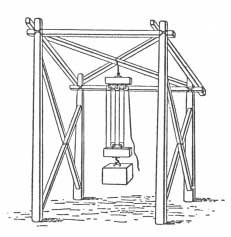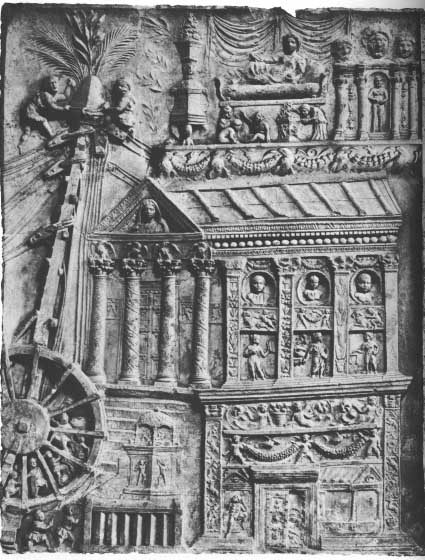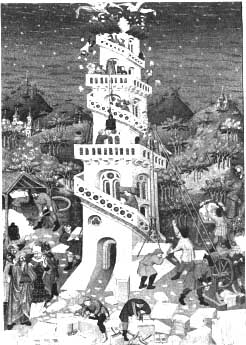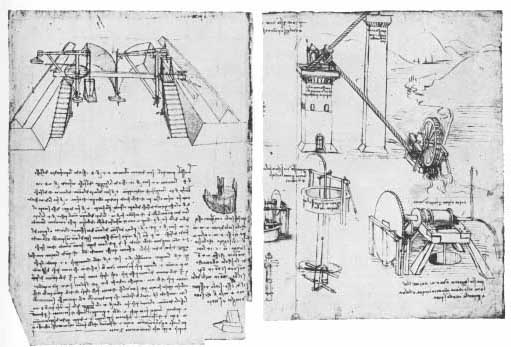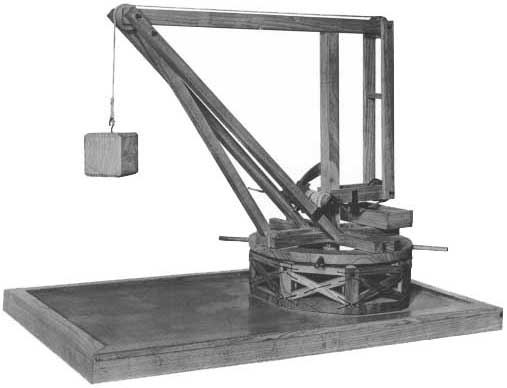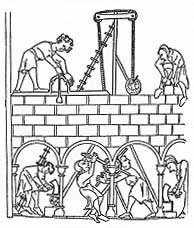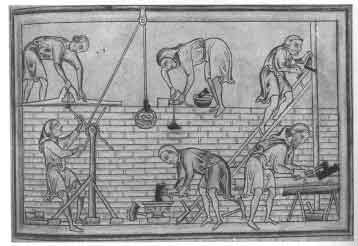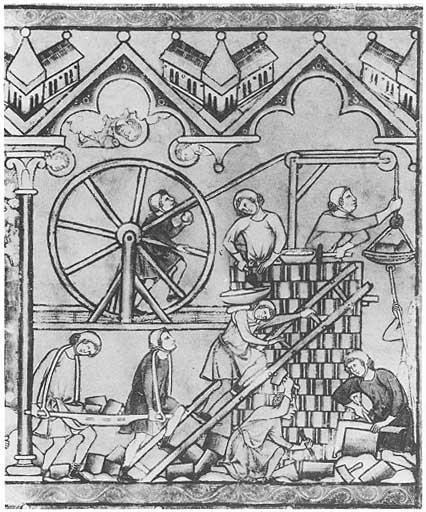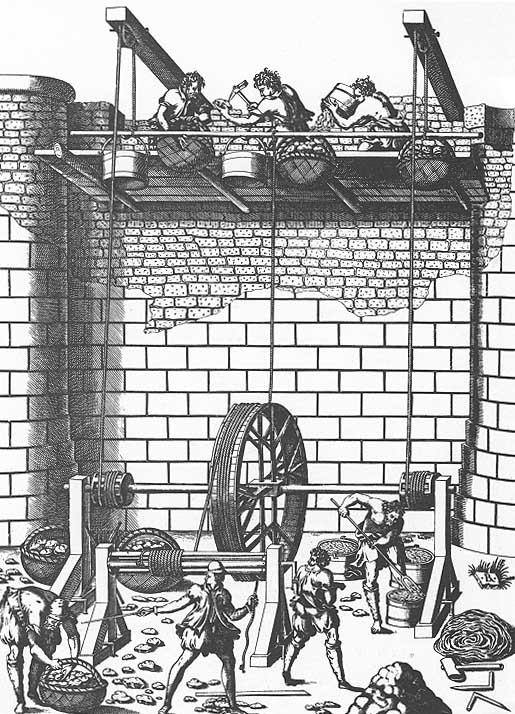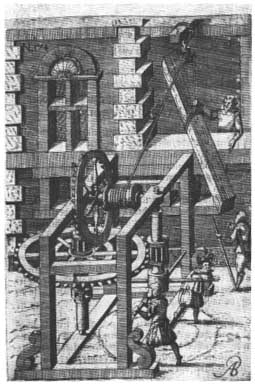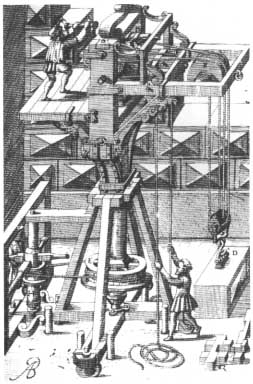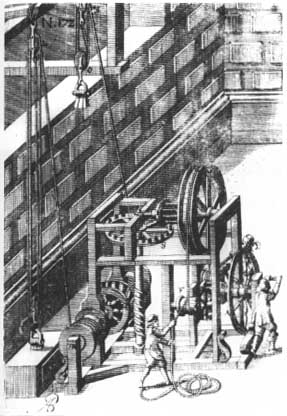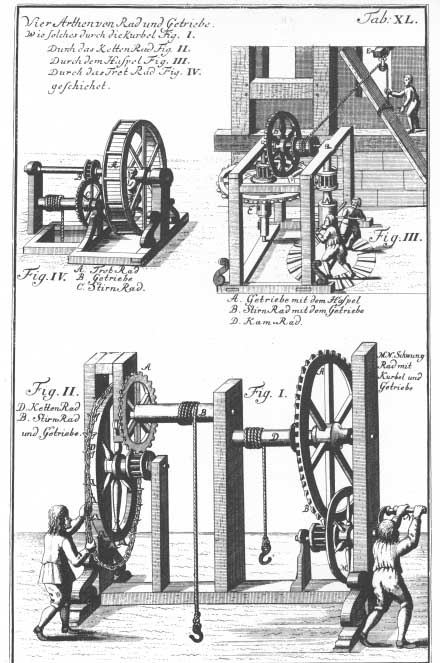|
(a-1-12)
|
| Reconstruction
of Greek lifting devices, showing first use of system of blocks
and tackle. Such lifting devices were described by Hero of Alexandria,
an inventor and mathematician living in the first century A.D. His
origin is uncertain although he wrote in Greek and conceived many
contrivances operated by water, steam or compressed air, including
a fountain and fire engine. |
|

|
(a-2a-9)
|
| The
tomb of the Haterius. This is the first known representation of the
treadmill. The crane has a quintuple pulley system on the hoisting
cable, with stay ropes each with a triple pulley. The two men at
the top are probably ensuring that the pulleys are well greased.
The wheel has a crew of five, two to provide the lifting power,
one observer to mark the position of the load, and a third man by
the wheel to use his own weight to make the very fine adjustments
needed to dock a load without risking serious accident. |
|
 |
(a-2a-2)
|
|
Rudolf von Ems "World Chronicle" from the 13th century
envisions the famed "Tower of Babel" being constructed
through the use of treadmill-powered hoists.
(Graphic Source: Cathedral,
Forge, and Waterwheel)
|
|
 |
(a-2a-11)
|
| A sketch (left) of
a crane, from Leonardo di Vinci's notebooks, together with a model
(right) from the sketch now in the Museo Nazionale Scienza e Tecnica,
Milan. First page of Leonardo's Codex Atlanticus, showing two mobile
cranes designed for use in canal building, to be powered by oxen.
The rotating cranes perform the dual function of excavating the
canal and using the earth to reinforce its banks. Each crane has
a long arm for the load and a shorter one for the ox platform. The
left-hand crane is in the unloading position, the right loading.
Once the crane's arm is fully laden, the ox is led onto the platform,
to act as counterweight and motive power.
(Graphic Source: Going
Up)
|
|
(a-2a-10)
|
 |
(a-2a-3)
|
| In the 12th and 13th
centuries, scores of cathedral and humdreds of churches were built
of stone requiring lifting by windlass, block and tackle.
(Graphic Source: Going
Up)
|
|
 |
(a-3-7)
|
| This team of masons
made use of a windlass with radiating spokes that could be operated
by two men if necessary -- an advantage over a crank. In this case,
the windlass is lifting a basket with a light load that looks more
like lunch than mortar or brick! Also recognized are a spirit level,
a plumb bob and line, an axe and an adze.
(Graphic Source: Cathedral,
Forge, and Waterwheel)
|
|
 |
(a-2a-4)
|
| Treadmill or squirrel
cage in use on a building site illustrated in a 12th century bible
from the Pierpont Morgan Library. Eighty cathedrals and over 500
churches were built in France alone between 1170 and 1270, which
gives an idea of the scale of such activity throughout Europe. Most
were built of stone, which required extensive quarrying. Pulleys
and hoists were used in both operations. Science Museum. London.
((Graphic Source: Going
Up) |
|
 |
(a-2a-5)
|
|
The use of windlass and reduction wheels to lift materials on
a jobsite.
(Graphic Source: Going
Up)
|
|
 |
(a-2a-6)
|
| In 1588, the Italian
engineer Ramelli published numerous copper etchings depicting numerous
lifting devices used in construction. Fig. 1 -- Rope winding drum
with toothed gears; Fig. 2 -- Tread wheel toothed step-down device,
worm and gear and windlass to block and tackle. ((Graphic
Source: The History of Cranes) |
|
 |
(a-2a-7)
|
| The stationary crane
serves to hold a superstructure, a portion of which contains a geared
hoisting system leading to a block and tackle. After the building
block has been elevated, the crane is made to rotate by roping connected
to a capstan -- spokes being manipulated by manpower. A workman
on the platform at the upper left may be making the final placement
and adjustments to the building block, mortaring it into place. |
|
 |
(a-2a-8)
|
| In
this graphic, a man is depicted lifting a large stone block to become
part of a very substantial wall. The elaborate system of sprocket,
pinion and worm gearing leads to a block and tackle at the load.
His fellow worker tends a rope leading over the top of a bull-wheel
braking device. He has wrapped the rope around a capstan, an assist
in maintaining tension upon the rope when the brake must be applied. |
|
 |
(a-1-13)
|
| Italian engineers depicted
the many kinds of reduction gearing -- treadmill, spur gear, windlass,
crank and chain fall -- that could in all shown cases increase the
lifting power of humans.
(Graphic Source: Going
Up)
|
|
 |











